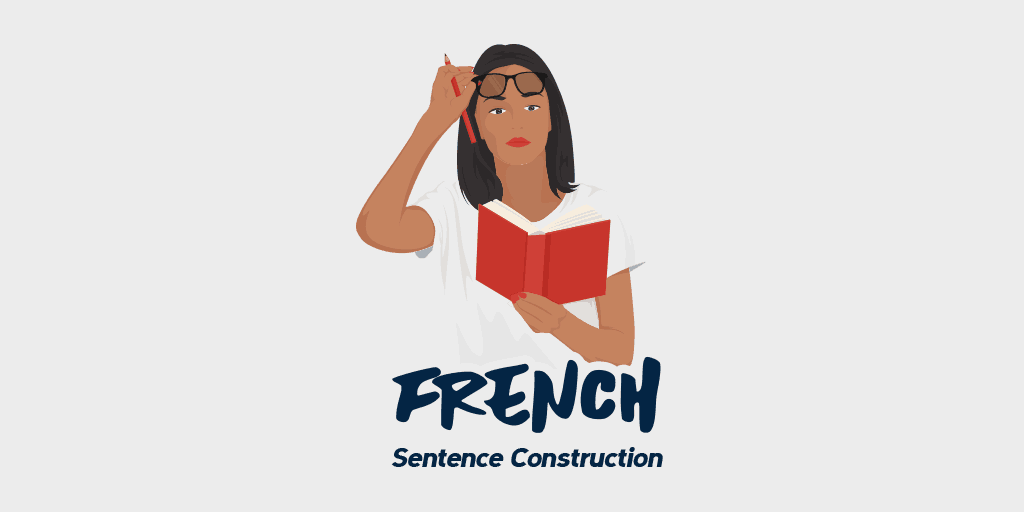When you learn a new language, you start by accumulating vocabulary, learning how to conjugate verbs and so on. But if you want to use it to communicate with others, you will also need to learn how to structure a sentence.
As native speaker, you know how to build a sentence instinctively but as a language learner, it takes a bit more practice. The good news for English speakers, or other Roman languages like Italian or Spanish, is that French sentence construction is similar in many ways to your own. However, there are also some difference that will necessitate some practice to sort it out.
Read more to learn the basics of French sentence structure that way making sentences in French will be easy for you!

Types of French Sentences
In French, there are four main types of sentences: statements (positive or negative), questions, exclamations and command. Here is our guide on how to build each one of these French sentences.
1. Statements
A. Positive statements
Statements, or declarative sentences, are the easiest way to approach French sentence construction. French, like English, follows the Subject-Verb-Complement structure sentence:
Je mange une pomme | I eat an apple |
Je mange une pomme à la maison | I eat an apple at home |
A la maison, je mange une pomme | At home, I eat an apple |
Je mange une pomme rouge | I eat a red apple |
Je mange une belle pomme | I eat a beautiful apple |
B. Negative statements
English only uses one negative word: not. French uses two: ne…pas. Ne is placed after the subject. Before vowels (a, e, i, o, u) or a mute h, ne becomes n’. Pas is placed after the verb.
Je ne mange pas de pommes | I don’t eat apples |
It also works with other negative statements: ne…que (only), ne…jamais (never), ne… quelque (a few).
Je ne mange jamais de pommes | I never eat apples |
C. Adding conjunctions
Once you have mastered the basic sentence structure, you can build longer, more complex ones by coupling shorter sentences together. They are linked with conjunctions : Mais (But), Où (Where), Et (And), Donc (So), Or (But), Ni (Nor), Car (Because), Puis (Then)…
Je mange une pomme car j’ai faim | I eat an apple because I’m hungry |
Still Stuck at Intermediate French?

Break through the plateau with our proven coaching and study method.
2. Questions
There are three basic ways to formulate a question in French.
A. Inversion
One of the most common ways to ask a question in French is to invert the subject and the verb in a sentence. Those questions can usually only be answered with yes or no.
Manges-tu une pomme? | Are you eating an apple? |
B. Est-ce que… ?
Instead of inverting subject and verb, the French also use the question tag Est-ce que at the beginning of the sentence and retains the sentence structure that follows. Est-ce que… demands a « yes or no » answer. It is considered more colloquial than an inversion question.
Est-ce que tu manges une pomme ? | Are you eating an apple? |
C. Question words
When asking an open question, French uses question words much like in English: qui (who), que (what), pourquoi (why), comment (how), quand (when), où (where), combien (how many, how much), quel (which)… They are sometimes followed by Est-ce que…
Pourquoi manges-tu une pomme ? | Why are you eating an apple? |
Qu’est-ce que tu manges ? | What are you eating ? |
3. Exclamations
Exclamations are used to express a strong emotion, such as surprise, indignation, etc. In many cases, they are similar in construction to declarative sentences and are marked by the intonation of the speaker or by an exclamation point when in writing.
Cette pomme est délicieuse! | This apple is delicious ! |
Exclamative words, such as quel/le, que or comme are used at the beginning of the sentence to emphasize a statement.
Quelle pomme délicieuse! | What a delicious apple ! |
4. Commands
Imperative sentences are used to express an advice, an order or a prohibition. It is the only type of sentence in French when the subject is dropped from the structure. It is usually implied by the conjugation of the verb in the imperative form.
Since it is a direct demand, it is either tu (the singular and informal form of “you”), vous (plural or formal) or nous (us). The sentence ends either with an exclamation point to mark emphasis or with a period.
Mangez cette pomme! | Eat this apple ! |
Mangeons des pommes. | Let’s eat apples. |
Sentence construction in spoken French
In French like in English, the spoken language tends to be more colloquial than what you would write in an essay. People tend to drop or shorten part of the sentence or on the contrary drag it on, which can make things a little trickier for a language learner. They do not always follow grammar rules to the letter.
For example, a question may only be marked by the intonation of the speaker rather than a change in the words’ order.
Tu as mangé une pomme ? | Did you eat an apple? |
The subject may be repeated for emphasis.
Cette pomme, elle était délicieuse. | That apple was delicious. |
Cette pomme, tu l’as mangée ? | Did you eat that apple? |
When it comes to negative sentences, some speakers tend to drop the “ne”.
J’ai pas mangé de pommes. | I didn’t eat apples |
See also: The Simple Guide to Informal French Grammar
Learning how to build a sentence in French fluently can seem tricky at first. Just like everything else, it comes more naturally with a lot of practice so take any opportunity you have to read, speak or watch movies in French.
Which part of the French sentence construction is the most difficult for you? Do you have any good tricks to get it right? Share it with us in the comments!
Learn how to build good sentences in French by brushing up in your grammar! Check out the French Grammar Bundle below.
Still Stuck at Intermediate French?

Break through the plateau with our proven coaching and study method.

Very nice explanation. It is so easy to understand and the method talkinfrench uses is superb. Outstanding website
Merci Achint
Excellent explanation – thank you very much Wendy
Thank you, merci Wendy
Thanks a lot. it really helped a lot.
merci beaucoup